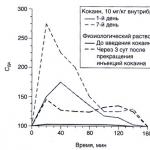Each garden has its own microclimate. Sunny, dry, wet, windy, secluded, warm, cold... how can we shape the microclimate of the garden? Is it possible to change it locally and adapt it to our personal needs?
The microclimate of the garden is influenced by both regional and local environmental conditions. Regional conditions boil down to the climate of a given region. Often, when making an entry in the gardener’s calendar section, at the end of the text they make a disclaimer that, for example, the dates they write about may be slightly different for different regions countries and what we can do in Kherson, for example, in mid-March, in Lviv it will be safer only in the first half of April.
We also know that on a climate scale, conditions can vary. This can be due to either human actions or natural conditions, i.e. terrain. For example, the temperature in highly urbanized areas will always be higher (even by a few degrees) than in rural areas, and the humidity lower. This is the result of the secondary development of the microclimate and is caused by the influence of technogenic factors.
I remember from my training days how they were always complaining about strong winds in some areas of the city, and how windy it was between blocks. Sometimes our teachers gave an example of this area as a place where local gusts of air and aerodynamic characteristics of the tunnel are formed, which in turn leads precisely to sharp gusts of wind even on seemingly windless days.
Human actions influence his environment and often determine the local microclimate. Moreover, if we can change it negatively, then we can also influence its specificity positively. This influence, of course, has its limits. I would define it more like artificial technology the same microclimate.
You already understand what we are talking about. No more, no less, I want to prove to you that you have power. The power of influence on the formation of the microclimate of your environment! The power is limited, but still. And further in the recording I will try to help you understand this power, i.e. this tool.
In order to begin to effectively and correctly use this power, we must have a good understanding of the mechanisms that control the microclimate at the local level. So that each of you can use it in your garden.
Analysis of local microclimate
Undoubtedly, knowing the local conditions of our garden helps. It is important to know exactly what factors are biotic and abiotic, that is, living and nonliving. Because both of them have an impact on the microclimate this place.
Analysis of the local microclimate is often included in the design of houses. Its results have an impact on the accepted initial design data. When I enter a given area, I immediately look where the south is, how the sun falls, where the shadow lies, what the relief and its surroundings look like, how the winds blow, etc. I look at a lot of things, but two of them I think are the most important. This:
- wind;
- humidity.
This is what they ultimately have greatest influence on the microclimate of a given place. And thanks to their control, this microclimate can ultimately be changed. But in order to change, you need to very carefully determine the method of implementation. This problem could be, for example, too strong wind in this place.
 An example of a garden diagram around a private house: orange - moderate lighting; yellow - strong; blue - shadow.
An example of a garden diagram around a private house: orange - moderate lighting; yellow - strong; blue - shadow. It rarely happens that we find ourselves on an empty field. As a rule, something grows in a given area. Below is a list of factors and landscaping elements that are especially worth paying attention to in terms of their impact on the local microclimate. You can be aware of their influence both in the context of designing a future garden and using it for an existing one.
- Fences, fences, walls;
- Residential and commercial buildings;
- Gazebos;
- Small architecture objects;
- Type of coverage;
- Reservoirs;
- Relief: elevations, hills, depressions, ramparts;
- Terrain exposure, tilt if necessary;
- Vegetation and in particular hedges, tall trees, vines;
As landscaping elements, they affect the microclimate in the garden
All vertical barriers such as walls, fences, hedges and old trees present an obvious barrier to wind and sun rays. This barrier limits or modifies the influence of these factors in to varying degrees depending on its design, height, etc.
In the context of vertical equivalent, there is one important thing to remember. Most often we perceive these partitions as a shield from the wind. However, there is another side to the coin in the literal sense of the word. A barrier like stone fence, has two sides. And if one of these sides is actually protected from the wind, then the other is subject to its accumulation and the formation of various turbulences. Consequently, conditions after a wind-exposed fence are significantly more unfavorable than if there were no barrier at all.
The same is true with the sun. Whether it's a fence or a building, there will generally be more shade on one side than the other. And again, the conditions, as before, will be very different. It is also worth remembering that what can be done on one side cannot be done on the other.
Did you know that from the point of view of improving the overall microclimate of the garden, it is better to create a continuous protective wall. Why? Because it gently dissipates the wind, softening the force of the blow without causing sharp changes air or accumulation. Hedges look great in this role, not to mention a wall of trees. When we go for a walk in the forest on a windy day, the moment we cross its threshold everything becomes silent and the wind loses its strength significantly. Planting trees in our gardens works the same way. Moreover, these living partitions do not cause air stagnation or moisture stagnation during the colder months. It is worth keeping in mind when installing any fences or barriers that too many of them can lead to not very positive consequences.
Another important factor One that has an impact on the local microclimate of the garden is the topography. Even on a scale small garden, a courtyard can have this meaning, not to mention mountainous areas or hills where all estates are located on slopes, have a certain slope, and therefore a special microclimate. It has long been known that on the southern slopes the herding begins much earlier than on the northern side. Southern exposure even in micro (for example, on a terrace) is a big bonus for us and our plants, creating much more favorable conditions for development, especially for heat-loving plants.
Did you know that cold air heavier than warm? Yes, yes, that's why we freeze in the valleys. And this also affects the conditions of the garden and private plots. Let's take, for example, the case that we installed a swimming pool, this is a recess in our garden. And what? And the fact that it is there that cold air masses can stop and are located.
Let us now take the question of humidity. Of course, the type of soil, groundwater level and independent terrain features are of primary importance for its parameters. We can influence it, that's obvious. If the humidity is too high, professional drainage or increasing the relief will solve the problem, and if the landscape is too dry, an irrigation system will help. And this is not the end. It is worth noting that, in addition to the obvious issues, water affects the local temperature increase even by 2-3 degrees, for this it is enough to have garden pond. The water gives off heat, due to which a slight warming is noticeable in the city, especially at night. Currently, this effect on a macro scale can be observed by residents of the coast, especially in autumn near the Black Sea, warmer air gives off heat, softening the temperature and reducing its amplitude (differences between times of day).
I started the article with an example of urban areas, writing that it is a little warmer there. But I didn’t say why, and this is important for both gardens and private plots. Wall coverings and structures absorb heat, which is then transferred to the environment. The more asphalt, paving stones, concrete, walls, the stronger this insulation effect is, because there are more batteries.
Let us finally take vegetation. Its presence has a huge impact on the local microclimate, both negative and positive. Plants release oxygen, increase air humidity, and release essential oils, reduce its temperature, improve hygienic conditions. As I already wrote, a grassy area can have a temperature lower than a concrete one, up to eight degrees. But only if we compare the lawn with asphalt the difference is shocking, because it is sixteen degrees.
Some trees can emit substances that are harmful to people or other plants. It is worth remembering the other side of the coin. Especially big trees result in insufficient rainfall reaching the base under the crown, which means unfavorable conditions moisture. Any overlap gives a similar effect.
Transparent garden house,as a local greenhouse method. The house is made of polyethylene film, the most cheap material which will help change the microclimate of the territory.
Conclusion
The microclimate of the garden can be consciously changed to some extent. However, we do not always have such an opportunity. And labor costs are not always commensurate with the result. Therefore, it may sometimes be worth trying to adapt the garden to local conditions, in terms of decisions and species selection. However, knowledge of the rules affecting the microclimate in the garden plays an important role. We use this knowledge not only to make changes, but also during the organization and daily use of the garden to optimize its composition and ease of use.
How to change the microclimate of the garden
11.08.2014
Microclimate in garden design - reasonable landscaping of the site.
Each of you has repeatedly heard the phrase about global warming. Perhaps not everyone agrees with this theory, since this summer is striking in its changeability. Temperature fluctuations even in one region, according to the hydrometeorological center, are significant, not to mention the differences between neighboring territories. One thing is certain: the climate is changing. You may be asking how this applies to you and why you decided to write about the weather, the answer is simple. The microclimate in each individual territory is very important, since it will be one of the determining components of your comfortable pastime. Let's discuss what is needed to make your holiday in the garden enjoyable. What tools will help you create comfort, coolness and calm.
Tools landscape design to create a microclimate.
We hasten to please you that you will not need anything unusual, expensive or supernatural. Everything is simple, as before, we create it using elements that are well known to us:
Trees;
Shrub;
Flowers planted in the form of flower beds, ridges, etc.;
Small architectural forms made of stone, wood, concrete and metal, etc.;
Engineering systems, communications.
 Every separate element, as a rule, is not able to solve the problem of heat, excess moisture or, on the contrary, dry air, protect completely from solar radiation. But with the correct combination of details, it is possible to partially influence the microclimate of a particular area. Below Anna will give some recommendations for creating comfort.
Every separate element, as a rule, is not able to solve the problem of heat, excess moisture or, on the contrary, dry air, protect completely from solar radiation. But with the correct combination of details, it is possible to partially influence the microclimate of a particular area. Below Anna will give some recommendations for creating comfort.
Everyone knows that stone and metal heat up in the sun, thereby increasing the overall air temperature. And in winter period they serve as an additional factor lowering the temperature. Keep this in mind when arranging elements using these materials in your garden. Wood used as decorative elements affects the ambient temperature much less. We will talk further about how plants influence them.
Should I choose group or single tree plantings?
 According to research, in places where trees grow in groups, even relatively small ones, the soil temperature is more stable. IN summer days, thanks to the thick crown, the surface warms up less, thereby maintaining moisture and coolness. While in winter, especially in coniferous forests, the branches restrain the winds and reduce the degree of cooling of the soil, and also prevent weathering.
According to research, in places where trees grow in groups, even relatively small ones, the soil temperature is more stable. IN summer days, thanks to the thick crown, the surface warms up less, thereby maintaining moisture and coolness. While in winter, especially in coniferous forests, the branches restrain the winds and reduce the degree of cooling of the soil, and also prevent weathering.
In summer, groups of trees and shrubs increase air humidity by an average of 10% more than if it were a steppe or field. Also, group plantings delay the flow of water from melting snow. Thus, the soil and air among the trees are more humid. 
If your site is located in a dry area, consider group plantings. If it is not possible to take large area under trees, arrange them with bushes. Try to shade the area as much as possible. At the same time, if your garden is prone to waterlogging, avoid group plantings, give preference to open spaces and single plantings of trees and shrubs, supplement them low-growing flower beds, discounts and so on.
When planting plants near buildings, take into account the fact that moisture retained by the tree can be adsorbed by the frames and other parts of the building.
What should you consider when choosing plants?
 Above I talked about how the density of plantings affects the microclimate of the site, but is that really all that matters? Many plants adapt well to their living conditions. So create garden design You can place the flower in an open space or in the shade. The plant adapts to its environment, although growth and flowering activity will be slightly different. While the differences between a plant in the sun and in dense shade will be striking. Therefore, when choosing trees, you should pay attention to the quality of the shadow created by their crown.
Above I talked about how the density of plantings affects the microclimate of the site, but is that really all that matters? Many plants adapt well to their living conditions. So create garden design You can place the flower in an open space or in the shade. The plant adapts to its environment, although growth and flowering activity will be slightly different. While the differences between a plant in the sun and in dense shade will be striking. Therefore, when choosing trees, you should pay attention to the quality of the shadow created by their crown.
If you have spruce, thuja, oak, catalpa, virgin grapes, ivy and similar plants growing on your site, the shade will be thick. In this case, choose shade-tolerant flowers that are not afraid of wet soil. They give an openwork shadow various types maples, willow, willow, wisteria and other plants. This is not a complete list of green garden abodes belonging to these categories. Before choosing a seedling, seek advice from professionals.

If you want to get a comfortable microclimate in a fairly short time, you can purchase. This allows, literally within one year, to obtain an element - an adult tree, the growth of which requires 5 years or more. Thus, using trees, shrubs and other landscaping elements, you can adjust the microclimate of a particular area. Before starting work, we recommend assessing the site, soil, groundwater and other characteristics. This will allow you to more correctly design and create a garden design, and avoid mistakes leading to the death of plants and unnecessary costs.
If you want to make your life much easier without worrying about small details, you can. She will perform a full range of work, create a cozy, comfortable landscape and microclimate on your site.
How nice it is to spend a holiday away from the bustle of the city. This is why many people buy private house or a dacha. No home is complete without garden plot. To make the site happy, it is necessary to carry out a huge part of the landscaping work garden. And here the main thing is not to make a mistake: before designing the site, you should analyze garden microclimate. Territory analysis is prerequisite, as it allows you to get a complete picture of the garden.
How to make a correct analysis of the garden microclimate
So, what should you pay attention to? First you need to conduct a soil analysis. This is done in order to find out the type of soil, as well as its chemical composition. After all, not every type of soil is suitable for agricultural work. Our country is rich suitable types soil, but some still require careful care and treatment with fertilizers.
For example, clay soil can be fertilized by adding peat or sand, but acidic soil needs the addition of ash. It should be remembered that any type of soil needs compost and humus. Chemical composition It is quite difficult to determine on your own, so this work will be done in a special laboratory.
After determining the type and composition of the soil, you should begin checking the site for the presence of groundwater. They can only be identified in July. This stage of the study is very important for the further improvement of the garden. If groundwater are about two meters from the surface, the area can be landscaped with any plants. If the level is higher, then the soil should be drained.
One of the options for soil drainage - This is an additional layer of soil that needs to cover the existing soil. Alternative option– carry out drainage pipes. In this case, water will leave the soil in a given direction.
 The next stage of research is the territory itself. It can be embossed or flat. Here the choice depends on the owner of the site. The relief area looks more impressive, and it can be decorated more interestingly. But in such a territory it will be difficult to create a level platform, since it will be necessary to build auxiliary supports, stairs, and terraces. But if such a huge amount of work can be completed, then you can safely design a garden plot.
The next stage of research is the territory itself. It can be embossed or flat. Here the choice depends on the owner of the site. The relief area looks more impressive, and it can be decorated more interestingly. But in such a territory it will be difficult to create a level platform, since it will be necessary to build auxiliary supports, stairs, and terraces. But if such a huge amount of work can be completed, then you can safely design a garden plot.
A flat area can also be beautifully decorated . With a little imagination, the site will be decorated with artificial mounds or embankments. Such decoration also visually enlarges the garden area. You can make a small pond or lake, and not remove the remaining soil, but use it just to create reliefs - embankments or hills.


Of no small importance for a garden plot there are winds. If the wind speed in the garden is more than 7-8 km/h, then you should think about what plants to plant, since not all species will be able to withstand such a gust of wind.
You should also pay attention to the shape of the site. The most practical are irregular shapes, since they are easier to improve and decorate. Meet rectangular plots, triangular, trapezoidal.
It is necessary to observe the movement of light and shadow in the area. The location of heat-loving plants depends on this.
How to create a microclimate in an apartment that contributes to the excellent well-being of household members - current issue for those who care about health and strive to create favorable living conditions in a confined space. Designers know effective ways filling the apartment with clean mountain air and maintaining.
How to heat your house without harm to your health
When the air temperature outside the window is low, it is extremely important to operate, which burns minimally the level of oxygen in living spaces with closed windows. To neutralize this effect, most manufacturers of convectors, oil and infrared heaters equips the equipment with built-in humidifiers and air ionizers. Some models are complemented by integrated fans that speed up the process of heating the room, but it is worth focusing on the opposite effect - rapid circulation automatically raises dust and saturates the air in the rooms with it, which negatively affects the respiratory system of residents. That's why the best way enhancing the effect of heating an apartment is an installation that can significantly increase the heat transfer of devices.
It will help to radically improve the microclimate in the apartment. From the point of view of doctors, the optimal room temperature is between 18-22 degrees. It is possible to set this heating mode or adjust it depending on individual needs by controlling thermostats that set the optimal operating mode. Besides functional system heating will not only help optimize the microclimate in residential premises, but also save the consumption of expensive heat energy.
Advice! If there is a lack of heat in the house, it is advisable to organize where at any time you can warm up and enjoy the peaceful atmosphere emanating from the hearth.
Thanks to the innovative developments of designers, apartment residents can install gas or with a realistic installation of a burning fire flame, the sound of crackling wood and coal, on equal terms with the owners of private houses. The advantageous feature of electric fireplaces is the absence of the effect of emitting combustion products harmful to health, which are characteristic of genuine home fires. The fashion for fireplaces intended for installation in apartments influenced the creation of a huge model range equipment that can look organically in any interior, be it ornate empire style.
Criteria for choosing windows for apartment equipment
The question “how to create a microclimate in an apartment”, where the air condition could be compared with countries with impeccable ecology, needs to be asked from the moment overhaul. Windows must be made exclusively from natural wood, allowing air to pass through external environment and not highlighting harmful substances during heating, unlike . When comparing polymer and wooden windows blocks, a number of factors can be identified that determine the state of the microclimate in the apartment:
- The ability of a tree to pass air affects recharge room air oxygen. Plastic neutralizes the effect of air exchange, creating a feeling of vacuum in a room with closed windows.
- Polymer profiles are characterized by a high degree of electrostaticity, which causes the attraction and accumulation of dust, which has a detrimental effect on the health of allergy sufferers. Therefore, the microclimate in an apartment with plastic windows is strictly contraindicated for residents with respiratory problems and children.
- When installing profiles from coniferous species wood (pine, fir or cedar) in the apartment you can breathe as easily and freely as in the forest. Coniferous trees even after felling and processing for many years isolated biologically active substances– phytoncides that disinfect the air from microorganisms harmful to health. It is worth noting that scientists have proven the fact that plastic releases dioxin when the polymer is heated, which produces a poisonous effect on others.
- The level of sound insulation of wooden profiles is significantly higher than that of plastic windows, since wood is capable of holding both low and high frequencies, while polymers are capable of holding only high sound frequencies. With wooden profiles most isolated from street noise.
Impeccable hypoallergenicity, high strength, and ability to withstand exposure to moisture, ultraviolet radiation, and temperature fluctuations provide excellent operational properties, which should be given preference if you want to create a healthy microclimate in the apartment.
Subtleties of selecting climate control equipment for an apartment
Setting out to create ideal conditions in internal environment apartment, you need to complete the primary task - choose climate control equipment. To facilitate the search, you need to measure the area of living quarters and study the indicators of a hygrometer that can determine the state of the microclimate in the apartment. The functional device is designed to control the climate conditions in an enclosed space, where it can instantly determine the temperature and humidity level of the air.
- – multifunctional device climate control technology, without which it is difficult to imagine life in dusty cities and provinces with constantly fluctuating heating conditions. Modern split systems are capable of cooling, heating, and humidifying air regardless of the street temperature and the operation of heating equipment. To improve the microclimate in studio apartment or, you should give preference to models with integrated system filtering and purifying air from dust and harmful impurities. They not only disinfect the air, but also enrich it with ions and phytoncides, which are sorely lacking in the air of urban areas. Modern technologies we have maximally improved split systems that are responsible for the state of the microclimate in the apartment. It is possible to control and monitor the operating mode of the air conditioner at a remote distance when Wi-Fi assistance. Thanks to the portability of the split system, you can set the optimal room temperature while at work, on a business trip, or in the car on the way home.
- Air washing gradually cleans and humidifies the air: it performs an antibacterial function, carries out plasma ionization, eliminates dust, animal hair and allergenic pollen, and enriches the space with moisture that is missing to the optimal level.
Advice! If there is not enough space for placement dimensional split system, equipment that humidifies the air, a microclimate system in the apartment will allow you to forever get rid of the problem of excessive dry air, dampness, insufficient heating or ventilation of living quarters.
A set of equipment equipped with combined engineering systems heating, air conditioning, ventilation, humidification and dehumidification - a universal climate control model. The prototype of such multifunctional equipment is a system that automatically creates an ideal microclimate in the apartment.
The microclimate of an apartment is determined not only by the operation of split systems, heaters, humidifiers and air purifiers, but also by the materials used for furnishing and decorating the rooms. It is extremely important to study the impact on environment certain details of the furnishings and cladding of the premises. Therefore, for finishing an apartment, you should give preference to those treated with organic dyes like zelige ( Moroccan style tiles), paper, paint with high hypoallergenic properties, and gypsum partitions, clinker brick, marble, granite, wood and others natural materials without treatment with chemical compounds.
Except beneficial influence on the environment finishing materials with a natural base, they are distinguished by durability of use and the ability to not lose their original appearance for a long time. Naturalness should be evident in every element of interior design.

















